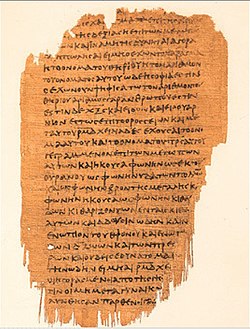Papyrus 47
| New Testament manuscript | |
 | |
| Text | Book of Revelation 9:10-17:2 † |
|---|---|
| Date | 3rd century |
| Script | Greek |
| Found | Egypt |
| Now at | Chester Beatty Library |
| Cite | F. G. Kenyon, The Chester Beatty Biblical Papyri III, (London, 1934). |
| Type | Alexandrian text-type |
| Category | I |
| Note | close to Sinaiticus, 0308 |
Papyrus 47 (P. Chester Beatty III), designated by siglum 𝔓47 (in the Gregory-Aland numbering of New Testament manuscripts), is an early Greek New Testament manuscript written on papyrus, and is one of the manuscripts comprising the Chester Beatty Papyri. Manuscripts among the Chester Beatty Papyri have had several places of discovery associated with them, the most likely being the Faiyum.[1] Using the study of comparative writing styles (palaeography), it has been dated to the early 3rd century CE.[2] The codex contains text from the Book of Revelation chapters 9 through 17. It is currently housed at the Chester Beatty Library (Inv. 14. 1. 527) in Dublin.[3][4]
In November 2020, the CSNTM in conjunction with Hendrickson Publishers released a new 1:1 high-resolution imaged facsimile edition of 𝔓47 on black and white backgrounds, along with 𝔓45 and 𝔓46.[5]
Text
[edit]The manuscript is a codex (precursor to the modern book), written with black ink on papyrus. The manuscript is quite fragmented, containing the text of Revelation 9:10-11:3; 11:5-16:15; and 16:17-17:2. The Greek text of this codex is considered a representative of the Alexandrian text-type (the text-types are groups of different manuscripts which share specific or generally related readings, which then differ from each other group, and thus the conflicting readings can separate out the groups, which are then used to determine the original text as published; there are three main groups with names: Alexandrian, Western, and Byzantine).[6]: 205–230 Biblical scholar Kurt Aland ascribed it as a Normal text, and placed it in Category I.[3]
The text of this manuscript is closest to Codex Sinaiticus (א), and together they are witnesses for one of the early textual types of the Book of Revelation.[7] Another type is represented by the manuscripts Papyrus 115 (𝔓115), Codex Alexandrinus (A), and Codex Ephraemi (C).[7] The text in 𝔓47-א is considered to be an inferior witness to the text of Revelation as opposed to that of 𝔓115-A-C.[7]: 76, 301, 391
See also
[edit]References
[edit]- ^ See main Chester Beatty Papyri page for full info.
- ^ P. Orsini; W. Clarysse (2012). "Early New Testament Manuscripts and Their Dates: A Critique of Theological Palaeography". Ephemerides Theologicae Lovanienses. 88 (4): 470.
- ^ a b Aland, Kurt; Aland, Barbara (1995). The Text of the New Testament: An Introduction to the Critical Editions and to the Theory and Practice of Modern Textual Criticism. Erroll F. Rhodes (trans.). Grand Rapids: William B. Eerdmans Publishing Company. p. 99. ISBN 978-0-8028-4098-1.
- ^ "Liste Handschriften". Münster: Institute for New Testament Textual Research. Retrieved 26 August 2011.
- ^ CSNTM, CSNTM and Hendrickson Publishers to Publish Third-Century New Testament Papyri Facsimiles
- ^ Metzger, Bruce Manning; Ehrman, Bart D. (2005). The Text of the New Testament: Its Transmission, Corruption and Restoration (4th ed.). Oxford: Oxford University Press. ISBN 0-19-516667-1.
- ^ a b c Comfort, Philip Wesley (2005). Encountering the Manuscripts. An Introduction to New Testament Paleography & Textual Criticism. Nashville, Tennessee: Broadman & Holman Publishers. p. 68. ISBN 978-0-8054-3145-2.
Further reading
[edit]- Kenyon, Frederic G. (1934). The Chester Beatty Biblical Papyri, Descriptions and Texts of Twelve Manuscripts on Papyrus of the Greek Bible: Fasciculus III - Pauline Epistles and Revelation (Text) (PDF). London: Emery Walker Limited. pp. xi–xiii, 17–35.
- Kenyon, Frederic G. (1936). The Chester Beatty Biblical Papyri, Descriptions and Texts of Twelve Manuscripts on Papyrus of the Greek Bible: Fasciculus III - Revelation (Plates) (PDF). London: Emery Walker Limited.
- Comfort, Philip Wesley; David P. Barrett (2001). The Text of the Earliest New Testament Greek Manuscripts. Wheaton, Illinois: Tyndale House Publishers. pp. 335–351. ISBN 978-0-8423-5265-9.
- Malik, Peter (2017). P. Beatty III (𝔓47): The Codex, Its Scribe, and Its Text. New Testament Tools, Studies, and Documents. Vol. 52. Leiden, Netherlands: Brill. ISBN 978-90-04-34043-5.

